Sedimentary Rocks
Picture Gallery of the Most Common Rock Types
Sedimentary rocks are formed by the accumulation of sediments. There are three basic types of sedimentary rocks: 1) clastic sedimentary rocks such as breccia, conglomerate, sandstone and shale, that are formed from mechanical weathering debris; 2) chemical sedimentary rocks such as rock salt and some limestones, that form when dissolved materials precipitate from solution; and, 3) organic sedimentary rocks such as coal and some limestones which form from the accumulation of plant or animal debris. Pictures and brief descriptions of some common sedimentary rock types are shown below.
Breccia | 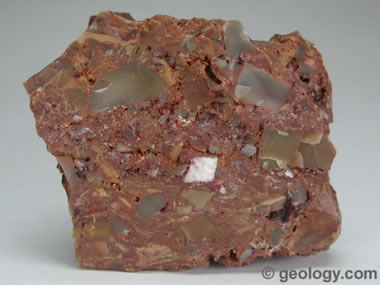 | | Breccia is a clastic sedimentary rock that is composed of large (over two millimeter diameter) angular fragments. The spaces between the large fragments can be filled with a matrix of smaller particles or a mineral cement which binds the rock together. The specimen shown above is about two inches (five centimeters) across. | Return to Top

Chert | 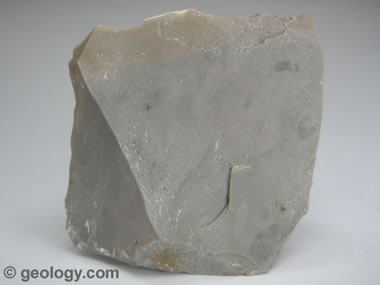 | | Chert is a microcrystalline or cryptocrystalline sedimentary rock material composed of silicon dioxide (SiO2). It occurs as nodules and concretionary masses and less frequently as a layered deposit. It breaks with a conchoidal fracture, often producing very sharp edges. Early people took advantage of how chert breaks and used it to fashion cutting tools and weapons. The specimen shown above is about two inches (five centimeters) across. | Return to Top
| Coal |  | | Coal is an organic sedimentary rock that forms mainly from plant debris. The plant debris usually accumulates in a swamp environment. Coal is combustible and is often mined for use as a fuel. The specimen shown above is about two inches (five centimeters) across. | Return to Top
Conglomerate | 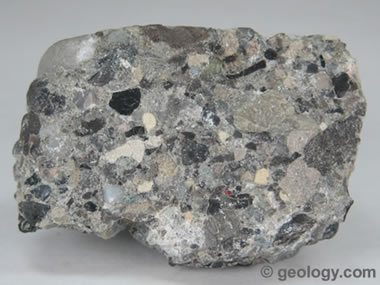 | | Conglomerate is a clastic sedimentary rock that contains large (greater then two millimeters in diameter) rounded particles. The space between the pebbles is generally filled with smaller particles and/or a chemical cement that binds the rock together. The specimen shown above is about two inches (five centimeters) across. | Return to Top
Iron Ore (Hematite) |  | | Iron Ore is a chemical sedimentary rock that forms when iron and oxygen (and sometimes other substances) combine in solution and deposit as a sediment. Hematite (shown above) is the most common sedimentary iron ore mineral. The specimen shown above is about two inches (five centimeters) across. | Return to Top
Limestone |  | | Limestone is a rock that is composed primarily of calcium carbonate. It can form organically from the accumulation of shell, coral, algal and fecal debris. It can also form chemically from the precipitation of calcium carbonate from lake or ocean water. Limestone is used in many ways. Some of the most common are: production of cement, crushed stone and acid neutralization. The specimen shown above is about two inches (five centimeters) across. | Return to Top
Rock Salt (Halite) | 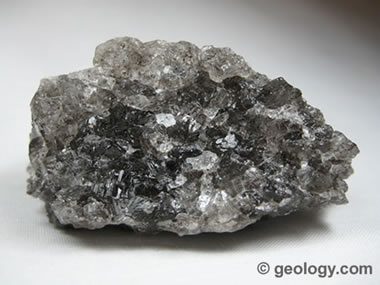 | | Rock Salt is a chemical sedimentary rock that forms from the evaporation of ocean or saline lake waters. It is also known by the mineral name "halite". It is rarely found at Earth's surface, except in areas of very arid climate. It is often mined for use in the chemical industry or for use as a winter highway treatment. Some halite is processed for use as a seasoning for food. The specimen shown above is about two inches (five centimeters) across. | Return to Top
Sandstone |  | | Sandstone is a clastic sedimentary rock made up mainly of sand-size (1/16 to 2 millimeter diameter) weathering debris. Environments where large amounts of sand can accumulate include beaches, deserts, flood plains and deltas. The specimen shown above is about two inches (five centimeters) across. | Return to Top
Shale | 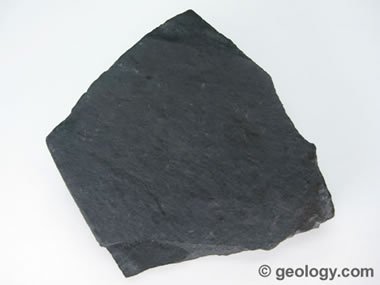 | | Shale is a clastic sedimentary rock that is made up of clay-size (less then 1/256 millimeter in diameter) weathering debris. It typically breaks into thin flat pieces. The specimen shown above is about two inches (five centimeters) across. | Return to Top
Siltstone | 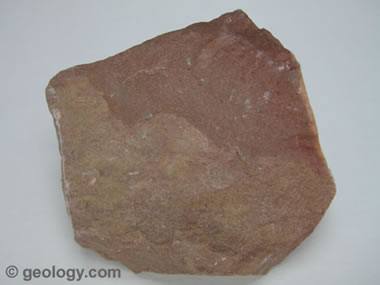 | | Siltstone is a clastic sedimentary rock that forms from silt-size (between 1/256 and 1/16 millimeter diameter) weathering debris. The specimen shown above is about two inches (five centimeters) across. | Return to Top |  |
| "A Grain of Sand": A gallery of sand grains from around the world as photographed through a microscope by Dr. Gary Greenberg. |
| Sliding Rocks: How these rocks slide across a dry lake bed is a mystery. Learn what is thought to move them. © iStock / S. Hoerold |
| Herkimer Diamonds: Learn how to find these doubly terminated quartz crystals at Herkimer, NY. |
| The Many Uses of Gold: Learn how the unique properties of gold make it extremely suited for a large number of industrial uses. |
| Meteorites: Learn about meteorites and how to identify them. |
| Uses of Granite: The rock used for everything from kitchen counters to street curbing to the facing stone of skyscrapers. |
|

No comments:
Post a Comment